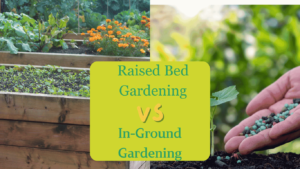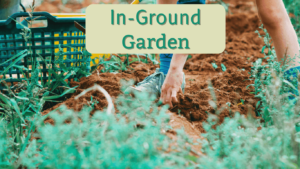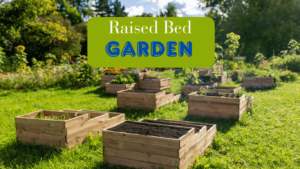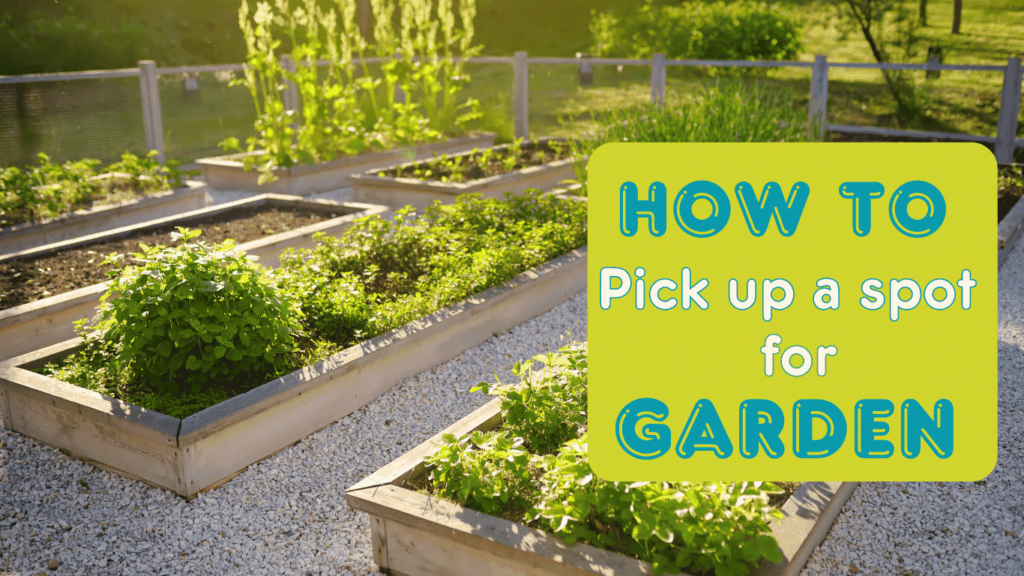There are two ways to grow a garden: raised bed gardening and in-ground gardening. Which is better?
Well! Every gardener will have a different opinion on that, so in this article. I’ll cover the pros and cons of each, my personal preference, and a few raised bed mistakes that people make, especially beginners, which need to be avoided.
When I’m talking about raised beds, it can be anything that has the planting medium framed in. Often, you’ll see raised beds made of wood, but they can also be made of stone, brick, metal, and many different materials.
Pros of Raised Bed Gardening

Here are the pros of raised bed gardening:
Soil dries and warms more quickly
The raised beds are more likely to dry out and then warm up sooner than ground-based beds. It’s great if you’re having to face dry, cold springs as well as shorter growing seasons.
For instance, if you’re in the wet or cold springtime, raising beds will enable you to harvest the early cold-season crops within a few weeks and even one month earlier than conventional in-ground gardening.
Better Soil Control and Nutrient Management
In a raised bed garden, it’s possible to alter the soil composition to suit the specific plant. You can mix high-quality compost-aged manure and any other nutrient-rich amendments to provide the perfect growing environment for your plant.
This allows you to improve the pH, levels of nutrients, and the appearance of your soil. It is ideally suited to the requirements of the flowers, vegetables, or plants you wish to cultivate. Therefore, in this case, you do not have to deal with the conditions of your soil.
Improved Drainage and Reduced Soil Compaction
The raised design in a bed for gardening can improve drainage when compared to gardens in the ground.
The soil that is elevated is less susceptible to becoming saturated with water, which could lead to root rot as well as other health problems for plants.
Additionally, it is not possible to walk directly onto the soil within raised beds. This prevents compaction that occurs in conventional in-ground gardens.
The reason for this is that the soil in a bed remains fluid and aerated to allow for the best root development.
Earlier Planting and Extended Growing Season
As I’ve said before, the soil gets dry out and warms up quicker in the bed garden, so it gives you the opportunity to plant your crop a few weeks earlier in any season.
To get these benefits, make sure to improve drainage and soil conditions. It’ll help you to continue growing later into the fall.
Easier accessibility for gardeners with mobility issues
Raised beds can also improve accessibility to the garden. It depends on how tall you build your beds; they can be much easier for people with mobility issues as compared to working in a ground field, where you’ve to bend a lot.
Less weed growth and easier maintenance
These raised beds serve as a barrier, making it difficult for weeds to invade the soil. This decreases the number of seeds for weeds to be blown in or carried away.
The beds that are raised are usually packed with top-quality, nutritious soil mix. The result is that it’s less suitable for the weeds to grow and flourish in comparison to normal garden soil.
Additionally, the raised bed garden’s height makes it easier to reach and remove weeds earlier before they grow. You won’t need to strain your back by bending over as you would in garden work.
I’ve mentioned it several times: the raised design improves drainage, heats up quicker during the springtime, and makes it difficult for weeds and weeds to gain a foothold.
Cones of raised bed gardening
We’ve discussed the many benefits of raised bed gardening, but there are also some disadvantages, and you should be aware of them before you make a final decision.
Initial Setup Cost and Effort
Even if you’re constructing two garden beds raised in your backyard, you’ll need to spend some money; however, you’re considering an investment of around a couple of hundred dollars. This could range from $200 to $500, based on the materials you choose to use.
The major expenses include wood or other materials needed to build the raised beds and the premium soil mix that is used to fill them.
The actual effort to construct beds can be very time-consuming, particularly when you’re building it yourself. But, for me, the initial effort is worth it because they provide the long-term benefits.
Limited Root Depth
The limited depth of soil in raised beds is an issue since it can limit the root zone for certain plants.
This is particularly true when it comes to crops that have deep taproots. For most commonly used herbs and vegetables, shallower soil is usually good.
Plants that have smaller, fibrous roots, like beans, lettuce, and other greens, are able to thrive perfectly.
However, if you wish to plant lemon plants, I’d suggest planting them in the ground, although I haven’t seen anyone growing large plants in beds.
However, it’s crucial to choose plants that are suitable for the raised bed. Plants with shallow roots, such as radishes, herbaceous greens, and leafy plants, are able to benefit from the dense and nutrient-rich soil.
Personally, I prefer raised beds for vegetables.
I also prefer using the ground to plant small fruit trees like Guava, Tomatoes, Lemon, figs, etc.
Soil Erosion and Drying
Raised beds are more susceptible to erosion of soil and drying out, as compared to gardens in the ground, due to their elevated, exposed design.
However, this issue can be reduced by mulching the soil’s surface and making sure there is adequate water availability.
The walls of a raised bed also assist in keeping the soil contained, which reduces the possibility of it leaking away during severe rainstorms.
A proper location for the bed, for instance, in a protected area, could further reduce issues that arise from drying out the soil.
Overall, gardening with raised beds provides many advantages but comes with some drawbacks, especially when you don’t need a big investment upfront and adjustments in your plant selection.
In-Ground Gardening

In-ground gardening, also known as traditional gardening, is when you plant directly in the existing soil of your garden or backyard. Let’s know some of its advantages.
The pros of gardening in-ground
Let’s look at the major advantages of in-ground gardening as compared to raised beds:
Lower Initial Setup Cost
In-ground gardening usually has lower initial costs than raised-bed gardens.
All that is required is to amend the soil within your yard, and it can be done quickly and cheaply.
There’s no need to build wooden frames or put soil mixes that are specially designed for raised beds.
The biggest expense might include compost and other amendments to soil; however, this is usually less expensive than the full soil mix needed to build raised beds.
Deeper Root Penetration
Root systems that are deeper, such as shrubs, trees, and a few vegetables, tend to thrive better in a garden that is in-ground versus the restricted roots of raised beds.
The unlimited soil depth allows your plant to expand its roots and gain access to more resources.
Additionally, it can be particularly beneficial to deep-root plants, such as fruit trees, since their roots spread and build the strongest, most stable base in the soil.
Larger Planting Areas
Another advantage of gardening in the ground is the capacity to create bigger, more extensive space for plants.
This is especially useful for plants that need larger spaces, like the vining plants, huge squash, or large herb gardens.
The ground level permits seamless flow and integration between different zones of growing while raised beds naturally restrict the overall area.
Thus, raised beds might be more suitable for a variety of vegetables. Their dense, nutrient-rich soil mixes are suitable for growing annual vegetables. In-ground gardens work best for plants that require deeper root plants.
Cons of in-ground gardening
We’ve discussed the pros of ground gardening, and now let’s know some potential cons of in-ground gardening as well:
Soil Quality and Nutrient Depletion
In-ground gardens depend on the soil’s condition in your backyard. They can also be deficient or deficient in vital nutrients over time.
The soil in a variety of suburban and urban areas has been compacted heavily and removed from organic matter after decades of usage.
This results in suboptimal growth conditions as plants are unable to get the nutrients they require. In-ground gardening and the maintenance of soil requires a constant effort to keep the soil’s fertility.
Soil Compaction and Drainage Issues
The weight of those walking on the ground can result in significant soil compaction over the course of time.
This will result in poor drainage because the compacted soil blocks water from effective absorption.
To solve this issue, you’ll need to do regular tilling and adding organic matter and, if possible, installing raised pathways in order to keep from stepping on plants.
Weed Management Challenges
In-ground gardens typically face more weeds that persist compared to raised beds.
The seeds of weeds can easily be blown in or carried into the garden, and their roots can grow deep into the soil.
Removing weeds from an in-ground plot takes more careful, active effort than the raised beds, as they have a physical barrier as well.
Accessibility issues for people with mobility issues
In comparison to raised beds, bending down to work in an in-ground gardening space can be difficult, particularly for those with mobility issues or back pain. I’m just 24, and I still have lower back pain issues.
However, the lower elevation means it is harder to reach the soil and plants with no strain. Raised beds, on the contrary, are constructed at a more comfortable height, which allows for greater access and reduces the physical strain.
My opinion is that gardens in the ground require more regular maintenance to deal with compaction, soil quality drainage, and problems with weed control.
However, the custom nature of raised beds is able to ease some of these issues and is what makes them appealing to the majority of gardeners who live at home.
Comparing Raised Bed vs In-Ground Gardening
Let’s make an honest comparison of raised bed gardening with in-ground gardening.
Soil Quality and Nutrient Management
Raised beds: the soil used in raised beds is usually an extremely nutritious, high-quality mix that is simpler to modify and keep. This gives you more control of the soil’s composition.
In-Ground: Soil quality can differ greatly based on the conditions of the soil. On the other hand, improving soil in the ground usually takes more energy to alter and build up nutrients.
Drainage and Water Management
Raised beds: They’re constructed to improve drainage, which helps prevent the accumulation of water and allows you to have greater control over levels of water.
In-Ground: Drainage can be more difficult for flat gardens in the ground, resulting in issues with overly wet and dry soil.
Growing Season and Plant Selection
Raised beds: The warm soil that drains better in raised beds allows you an earlier beginning of the growing season and also allows for a greater variety of plants that can be grown successfully.
In-Ground: The ground in flat gardens could require a longer time to heat in the spring, which limits the possibility of crops that are cool-season and also extends the time before the planting process can start.
Maintenance and Weed Control
Raised Beds: As we have discussed earlier, the physical barriers and soil conditions of raised beds make it simpler to control weeds and require less maintenance.
In-Ground: Weeds are much more destructive and demand a constant effort to control in traditional gardens.
Accessibility and Ease of Use
Raised Beds: a higher level of raised beds makes gardening tasks such as gardening, weeding, and harvesting more comfortable and easy, particularly for those who have mobility issues, like those who can’t bed or have lower back pain issues (including myself).
In-Ground Gardening: Kneeling, bending, etc., may be more physically demanding in the in-ground garden.
So, gardening in raised beds has many advantages, including soil quality, conditions for growth, and ease of maintenance. However, it will require an initial investment.
In-ground gardening is also a good option, but it will require more effort on a regular basis to control both the weeds and soil.
Factors to Consider When Choosing Between Raised Bed and In-Ground Gardening

Let’s talk about the most important factors to take into consideration when deciding between raised beds or in-ground garden:
Gardening Goals and Priorities
- Take note of what you are most likely to plant – some plants are more suited to one environment than another; they can be raised beds or ground.
- Consider the desired aesthetics, maintenance requirements, and yield. Raised beds may provide an attractive appearance and make it easier to maintain.
Available Space and Layout
- You should evaluate the dimensions, shape, and layout of your garden area.
- Raised beds are great for tiny or oddly shaped areas. In-ground beds are better for large, open spaces.
- The placement is equally important; the raised beds are set on decks, patios, or even on sloped terrain.
Soil Quality and Condition
- Check the soil that is in place to see whether it is nutrient-deficient or compacted. Or is it contaminated? Raised beds let you begin with a soil that is high-quality and healthy.
- If you’ve got great native soil, then in-ground gardening could be a good option, and if the ground soil is contaminated, then consider going with beds.
Your Physical Abilities and Preferences
- Take into consideration your mobility, back health, and gardening experience.
- Raised beds help reduce bending and make maintenance more easy and ideal for people who have physical limitations.
- The personal style of gardening and the preferences can also be a factor.
Budget and Resource Constraints
- The construction of raised beds requires an investment upfront in soil and materials.
- In-ground gardens typically have lower initial costs but might require more regular maintenance.
- Consider your time, money, and other resources before making a decision.
Conclusion
In my opinion, gardening with raised beds is an excellent option for many homeowners. However, there are a few important factors to think about.
In the beginning, for instance, the initial set-up costs and time to build raised beds are higher than planting directly into the soil.
However, the benefits that will come over time usually make it worthwhile to invest in a bed garden.
The major benefits of raised beds are decreased weed growth, less maintenance, and better soil quality and drainage.
Overall, I think raised beds are a great option that yields abundant harvests in a lesser amount of effort when compared to traditional in-ground plots.
However, the ultimate decision depends on your gardening goals, the space you have available, and your own preferences. I personally like both, but I will choose beds for growing my vegetables, as I also have lower back pain issues.

